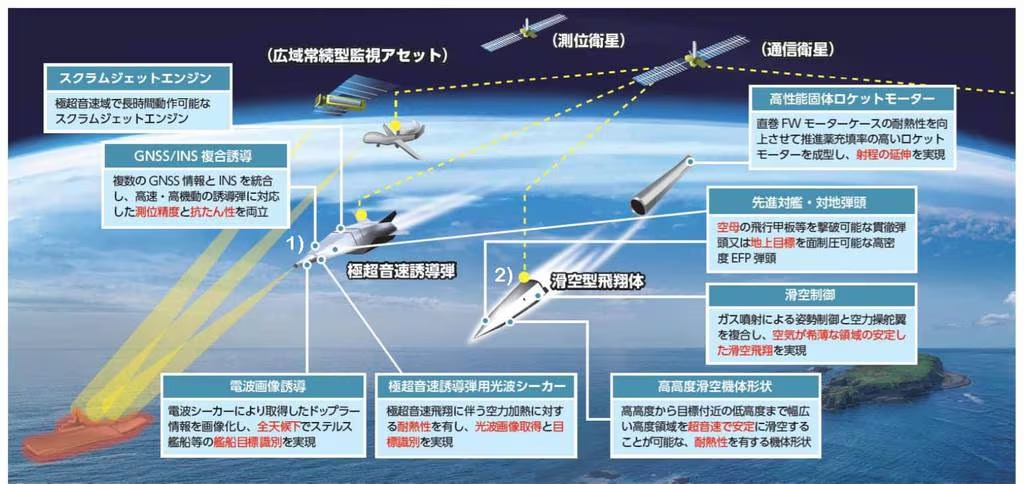Japan has successfully carried out a series of flight tests for its hypersonic glide vehicle as part of efforts to enhance its stand-off defense capabilities.
Japan’s Acquisition, Technology, and Logistics Agency (ATLA) announced on February 7 that tests of the Hyper-Velocity Gliding Projectile (HVGP) were conducted in California, with all four flights successfully achieving their objectives.
The latest test took place on January 25. The series of trials was aimed at gathering critical data for further development of the HVGP.
The first test in this phase was conducted in August 2024, followed by two in November, and the final test in January 2025. However, this is not the first time the testing of this system has been announced.
Japan first disclosed its hypersonic glide vehicle testing in 2024, revealing that tests had already been conducted in March and April of that year. That was the first time Tokyo publicly confirmed that it had begun trials of its advanced hypersonic weapons program.

The country’s research and development on high-speed glide munitions started in fiscal 2018. The Japanese Ministry of Defense has set a goal to complete research on high-speed glide munitions for island defense by fiscal year 2025.
The project is a key part of Japan’s broader effort to bolster its stand-off capabilities, particularly in response to growing security challenges in the Indo-Pacific region.
According to an official timeline from the Ministry of Defense, following additional tests, the first deliveries of the HVGP are expected to begin between fiscal years 2026 and 2027.
This would ensure that Japan’s Self-Defense Forces (SDF) receive these cutting-edge weapons as soon as possible to reinforce the country’s deterrence capabilities.
The Ministry confirmed that the latest flight test proceeded as planned, meeting all objectives. Additionally, the mass production of the HVGP has already commenced as of fiscal year 2023, signaling Japan’s intent to deploy these advanced weapons without delay.
Japan’s Hyper-Velocity Gliding Projectile (HVGP)
The HVGP is a major step in Japan’s defense modernization efforts and is envisioned primarily for island defense. The development of hypersonic glide vehicles aligns with Tokyo’s strategic focus on securing its remote territories, particularly as regional threats continue to evolve.
By advancing its hypersonic weapons capabilities, Japan is positioning itself among the leading nations in this cutting-edge military technology to ensure that it remains prepared to counter emerging security challenges.
The HVGP is classified as a stand-off missile, meaning it is designed to strike targets from a safe distance beyond the reach of enemy defenses.
This makes it particularly effective for engaging hostile forces that may occupy remote Japanese islands. It will allow the Japan Self-Defense Forces (JSDF) to launch attacks while remaining outside the enemy’s engagement zone.
The missile operates in two distinct phases. Initially, a solid-propellant rocket booster propels the projectile to a high altitude. Once it reaches the desired height, the warhead separates from the booster and begins its glide phase, traveling at hypersonic speeds toward its target.

The extreme velocity of the HVGP makes it difficult for enemy air defense systems to track and intercept, enhancing its effectiveness as a deterrent and strike weapon.
For guidance, the HVGP primarily relies on the Global Navigation Satellite System (GNSS), which allows precise targeting. Additionally, an inertial navigation system serves as a backup to maintain accuracy even in cases where satellite signals are disrupted.
When engaging moving targets, such as warships, it is believed that the missile will employ additional guidance mechanisms, including radio-frequency imaging and infrared homing, to increase its strike accuracy.
To operationalize the HVGP, Japan’s Ministry of Defense is considering establishing two specialized units within the Japan Ground Self-Defense Force (JGSDF).
According to defense ministry officials, Kyushu and Hokkaido are being evaluated as potential locations for these missile batteries. The placement of these units would provide strategic coverage over Japan’s key maritime approaches and contested island territories.
In addition to the HVGP, Japan is actively working on an upgraded version of the Type-12 surface-to-ship missile, which is expected to have an extended range of approximately 1,000 kilometers.
The move toward acquiring long-range precision-strike capabilities is a departure from Japan’s post-World War II defense policies.
While Tokyo has traditionally refrained from developing offensive strike weapons, its current trajectory suggests a more proactive approach to ensuring national security.
- Contact the author at ashishmichel(at)gmail.com
- Follow EurAsian Times on Google News




